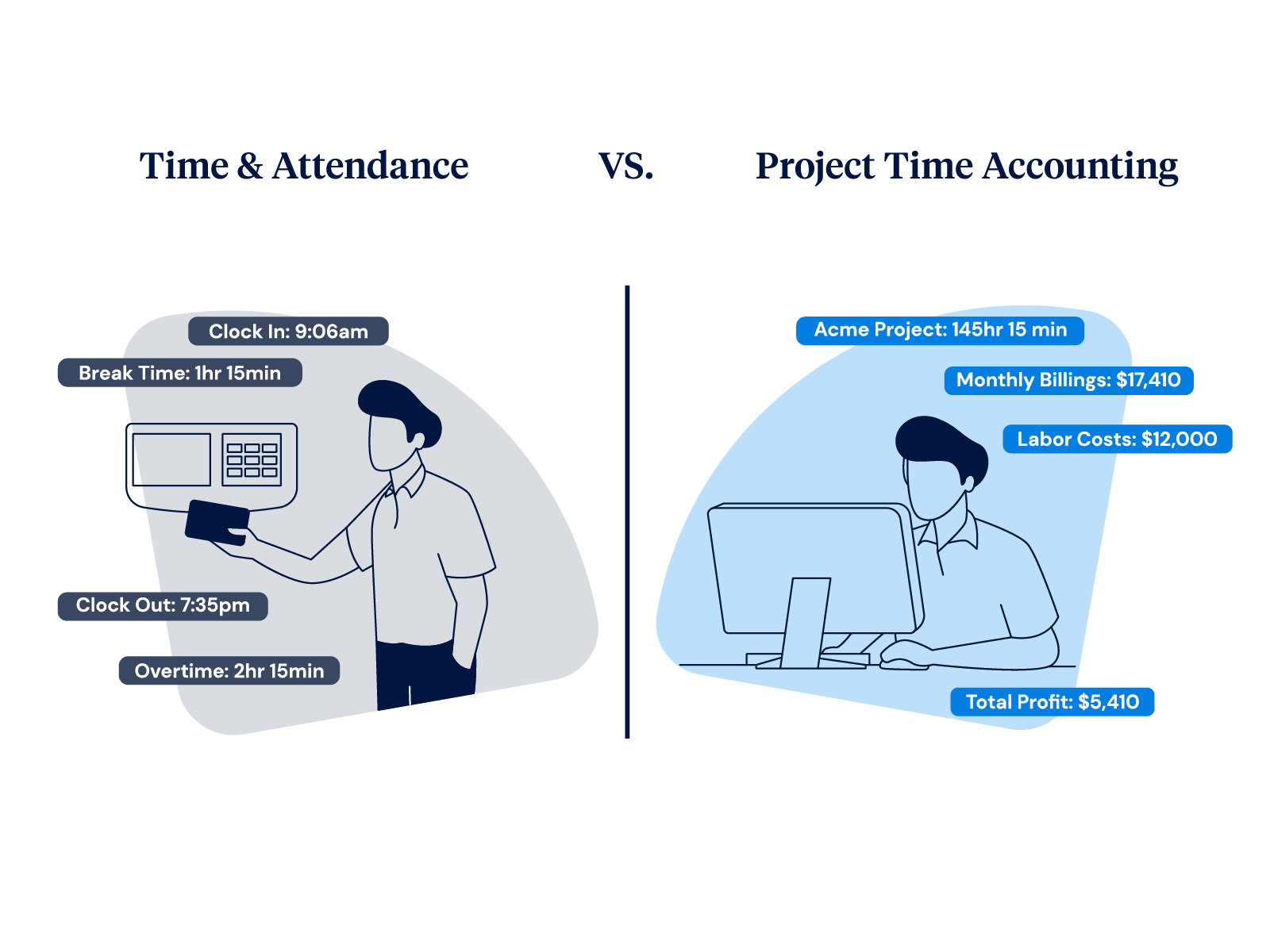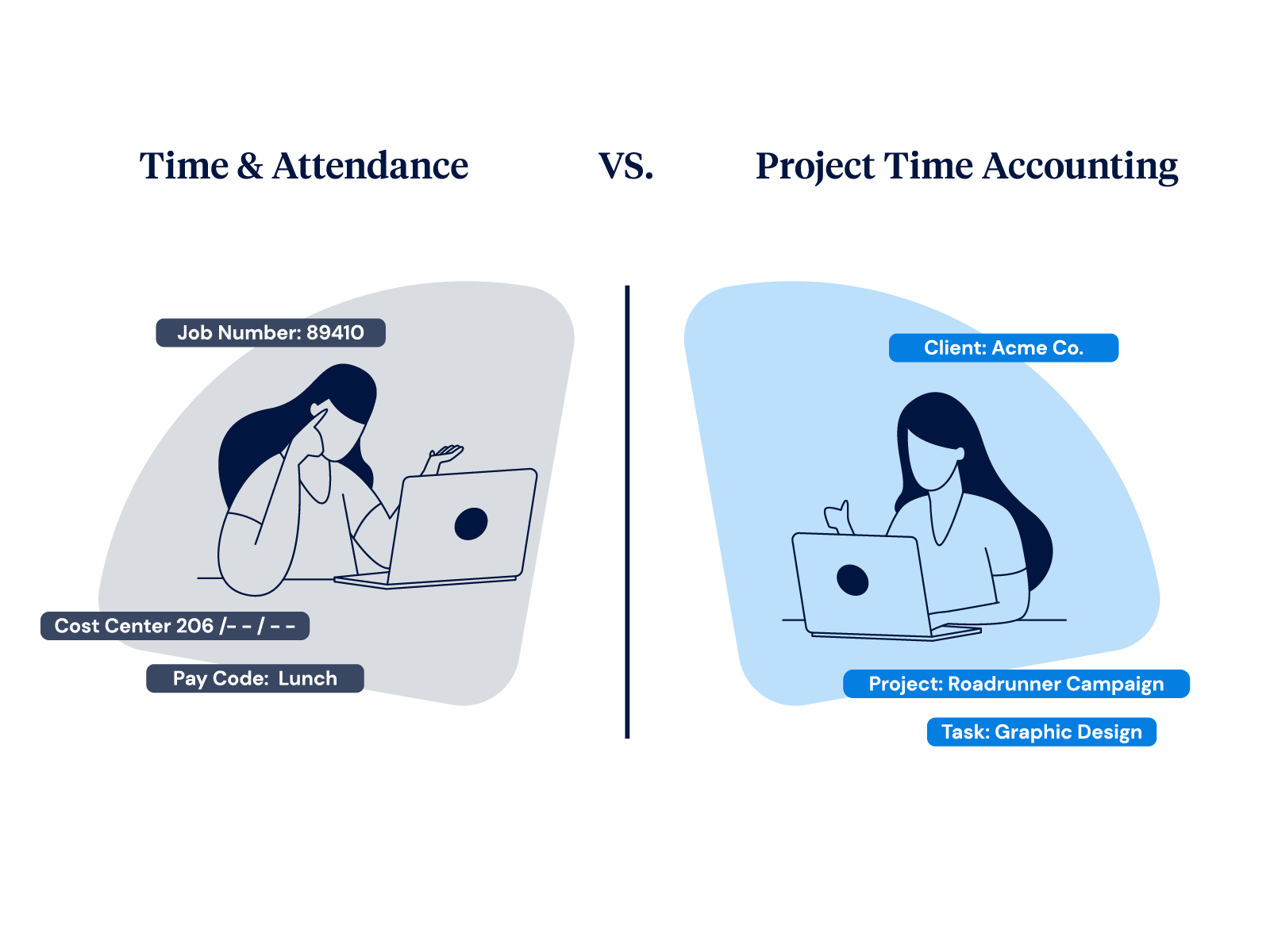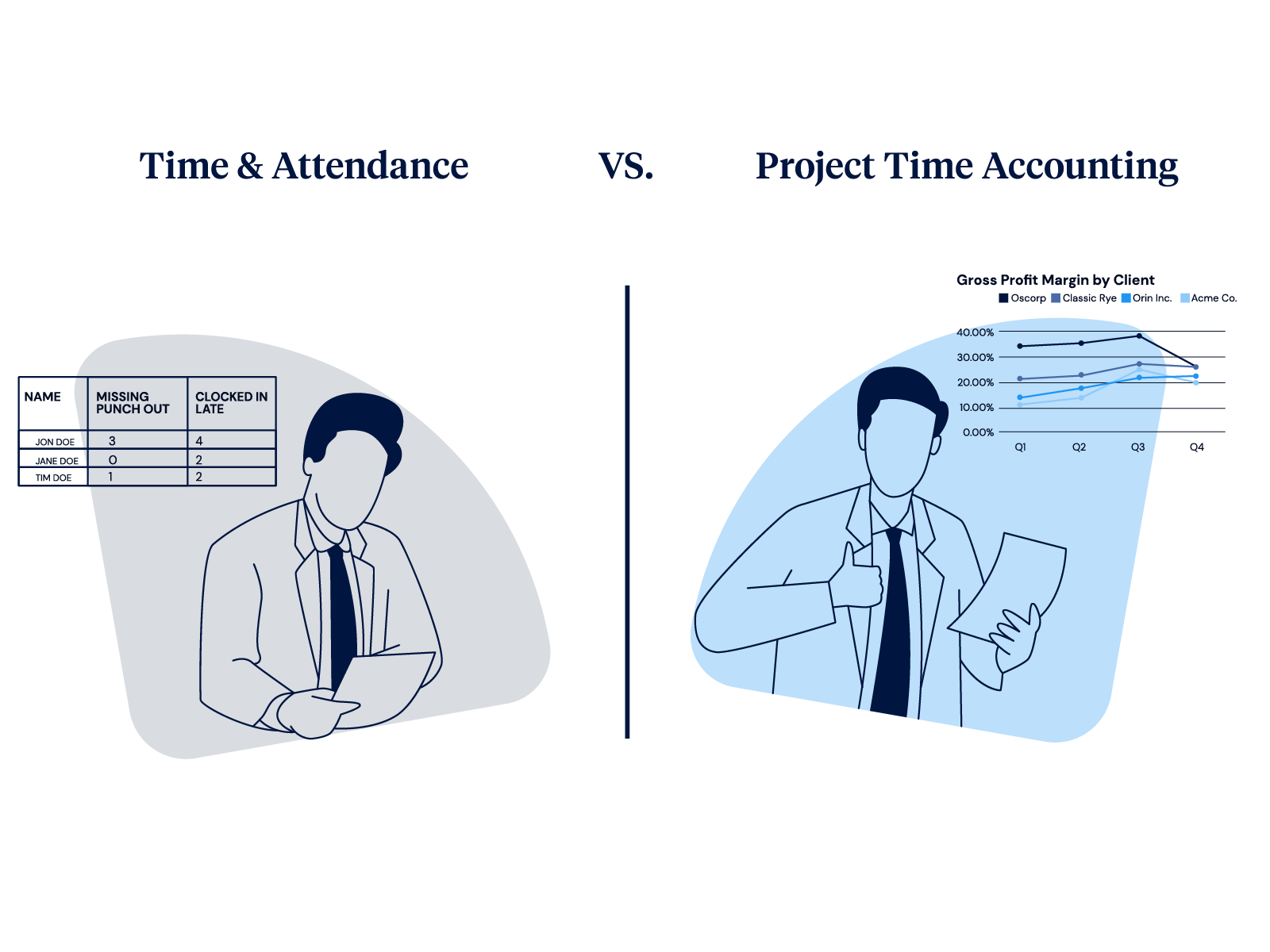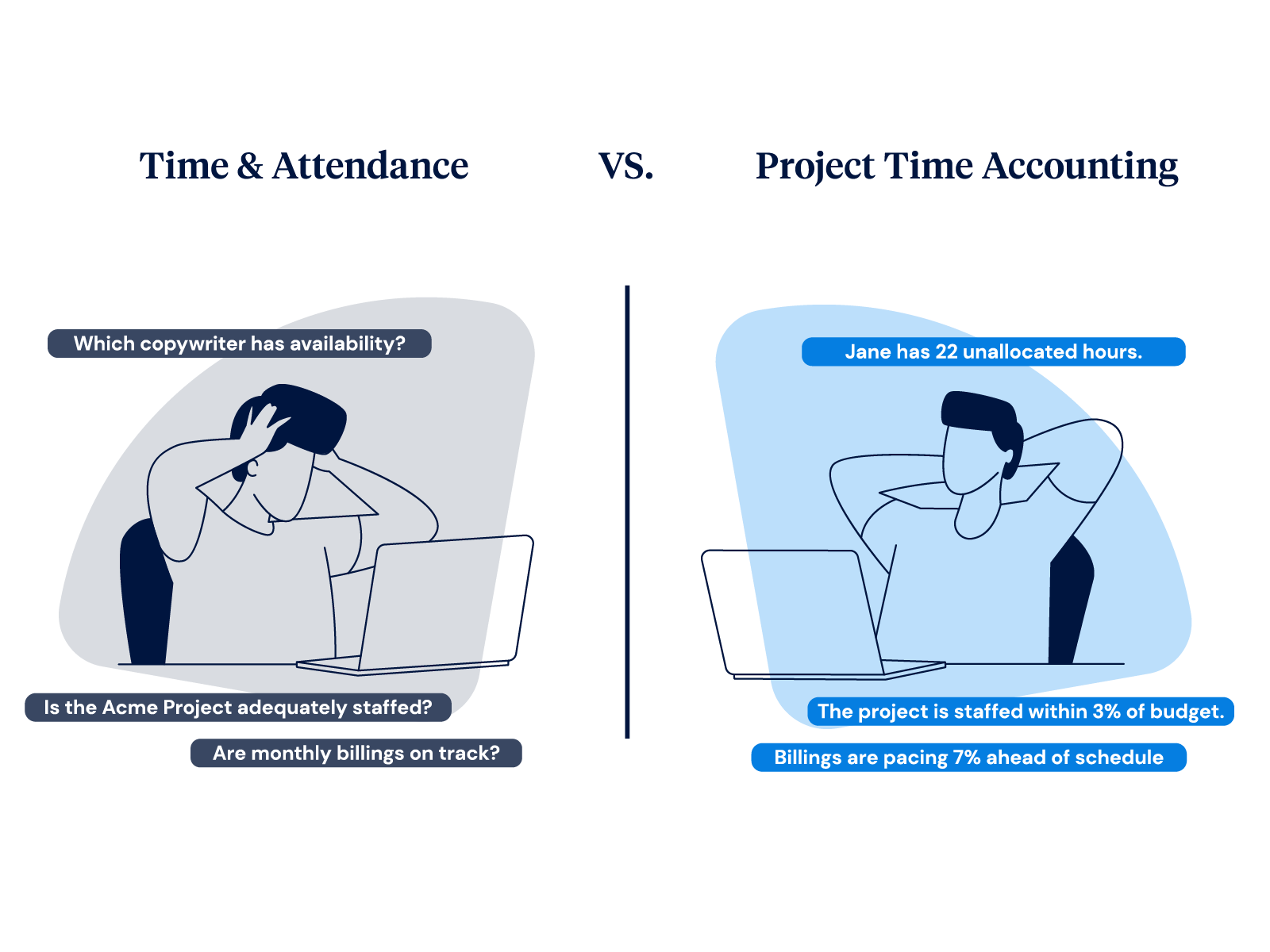Payroll Systems: Perfect for Punching In, Poor at Project Time Tracking
Table of Contents
In a world where every minute counts, organizations must be diligent about how they manage time and payroll.
And while using your payroll system for time tracking may seem like a practical solution, this approach can lead to numerous problems.
In this article, we’ll explore the reasons why a dedicated time-tracking system is essential for any organization, and the challenges and limitations that can arise from relying on payroll systems for time management.
Payroll Systems are Built for Time & Attendance, Not Project Time Tracking
Payroll systems are generally designed to handle time and attendance tracking for the purpose of calculating employee wages and ensuring compliance with labor laws. However, they typically lack the necessary features and functionality to effectively track project time and manage labor cost accounting. This limitation can lead to several issues for companies that require detailed project-based time tracking for cost allocation and budget management.
Some of the challenges faced by companies using payroll systems for project time tracking and labor cost accounting include:
- Inability to accurately allocate employee hours to specific projects or tasks, making it difficult to determine the true cost of each project and evaluate project profitability.
- Limited visibility into resource utilization, hindering effective decision-making and resource allocation for ongoing and future projects.
- Difficulty in monitoring employee productivity on specific projects or tasks, preventing managers from identifying bottlenecks and areas for improvement.

- Accurately track and allocate employee hours to individual projects or tasks, providing a clear picture of project costs and profitability.
- Gain insight into resource utilization, enabling more informed decision-making and efficient allocation of resources.
- Monitor employee productivity on specific projects or tasks, helping managers identify areas for improvement and optimize team performance.
By implementing a dedicated time tracking system, companies can effectively manage project time and labor costs, leading to more accurate financial reporting, better decision-making, and improved project outcomes.
Payroll Systems Don’t Prevent Timesheet Inaccuracies and Human Error
Payroll systems, while designed for managing employee compensation, often fall short when it comes to handling the complexities of time tracking. Their lack of specialized features often forces businesses to adopt unnecessarily complicated processes for tracking and updating employee hours, which increases the risk of human errors and inaccuracies.
In contrast, dedicated time-tracking systems are designed to minimize these risks and provide real-time, accurate data, ultimately improving overall efficiency.
Key benefits of using a dedicated time tracking system to reduce inaccuracy and human errors include:
- Automated Time Tracking: Many dedicated time tracking systems offer automated features, such as timers or predictive logging, that accurately record the time employees spend on tasks or projects. This automation reduces the reliance on manual entry and diminishes the risk of errors and inaccuracies.
- Validation and Approval Processes: Time tracking systems often include validation and approval features, allowing managers to review and approve employee timesheets. This additional layer of oversight helps catch any errors or discrepancies before they impact payroll or project management.
- Time Tracking Reminders and Notifications: Many dedicated time-tracking solutions offer customizable reminders and notifications that prompt employees to submit their timesheets or update their time entries. These prompts help minimize the risk of forgotten or inaccurate entries, ensuring that time data remains consistent and reliable.
- Customizable Time Entry Templates: Dedicated time tracking systems often provide customizable time entry templates, allowing organizations to tailor their time tracking processes to their specific needs. These templates can include custom and hidden fields, allowing additional information to be added to each time entry while reducing the manual inputs required of employees. This customization helps ensure that employees accurately capture all relevant information, reducing the risk of errors and misunderstandings.
- Real-Time Data Access: Dedicated time tracking systems provide real-time access to time data, ensuring that managers and employees always have the most up-to-date information. This timely access helps prevent errors arising from outdated or incomplete data and promotes accurate decision-making.
By investing in a dedicated time-tracking system, organizations can significantly reduce the risk of inaccuracy and human error. This improvement in accuracy and efficiency ultimately leads to better project management, more precise financial reporting, and increased overall productivity.
Unintuitive Timesheet Interfaces Frustrate Employees
Payroll systems are not designed with user-friendly interfaces for employees to track their time. In many cases, employees are required to input project codes, cost centers, or other unintuitive information in order to log their hours accurately. This complex and confusing process can lead to frustration among employees, who may become resentful of the time-tracking system.
This frustration can cause employees to procrastinate in logging their hours or inaccurately report their time. In turn, this can lead to inefficiencies in payroll processing, incorrect compensation, and increased tension between management and employees. 
By implementing a dedicated time tracking system, companies can reduce employee frustration and resentment, fostering a more positive work environment and promoting greater transparency in time management. This not only improves overall efficiency but also contributes to higher employee satisfaction and engagement.
Payroll Timesheets Have Limited Customizability
Timesheet customizability in payroll systems is usually limited, resulting in fewer dimensions available for employees to track their time.
For example, payroll systems typically only provide two tiers of object hierarchy, allowing users to log time to “Projects” and “Tasks.” This restricted hierarchy can make it challenging for organizations to accurately capture and organize time data based on their specific requirements.
In contrast, dedicated time-tracking systems offer greater flexibility. Out of the box, these systems come with 3 tiers of object hierarchy, allowing employees to log time to “Clients, Projects, and Tasks” (or “Programs, Initiatives, and Activities” – the nomenclature is up to you). This additional layer of hierarchy enables businesses to better organize and categorize their time data, resulting in more precise reporting.
Furthermore, dedicated time tracking systems often provide the ability to add custom fields to timesheets, allowing organizations to capture even more granular data, such as job codes, capex vs. opex labor classifications, or billable/non-billable hours. This level of customization enables businesses to tailor their time tracking solution to their unique needs, providing a more comprehensive understanding of employee time and productivity.
In summary, the limited customizability of timesheets in payroll systems can hinder effective reporting and workforce management. By opting for a dedicated time-tracking platform, organizations can benefit from greater configurability and more precise data capture, ultimately leading to better decision-making and improved project outcomes.
Insufficient Reporting Capabilities Stymie Insights
Payroll systems weren’t built to analyze time data. Limited reporting and analytics capabilities in payroll systems hamper a company’s ability to gain insight into employee productivity, project efficiency, and resource allocation.
Dedicated time-tracking systems, on the other hand, provide comprehensive reporting and analytics tools that enable managers to make data-driven decisions for improving processes and optimizing resources.

- In-Depth Employee Productivity Analysis: Time tracking systems with robust reporting features allow managers to analyze employee productivity on individual tasks, projects, or teams. This insight helps identify areas of improvement, training needs, or potential workload imbalances, leading to better workforce management.
- Project Performance Evaluation: With dedicated time tracking systems, managers can assess project performance by analyzing factors such as time spent, budget consumption, and resource allocation. This information helps in identifying bottlenecks, reallocating resources, and adjusting project timelines or budgets as needed.
- Resource Allocation and Utilization Insights: Comprehensive analytics tools in time-tracking systems provide valuable insights into resource allocation and utilization. Managers can identify overutilized or underutilized resources, enabling them to make informed decisions on resource reassignment or capacity planning.
- Trend Analysis and Forecasting: Advanced analytics features in time-tracking systems enable organizations to analyze historical data and identify trends, providing valuable input for future planning and forecasting. This can help companies proactively address potential challenges and optimize resource allocation for upcoming projects.
- Improved Accountability and Transparency: Comprehensive reporting and analytics tools in dedicated time-tracking systems promote accountability and transparency among employees and teams. With access to accurate, real-time data, managers can establish clear performance expectations and measure progress against defined goals.
- Customizable Reports: Dedicated time-tracking systems often offer customizable reporting options, allowing organizations to create tailored reports that align with their specific needs and requirements. This level of customization ensures that relevant information is easily accessible for decision-making and performance evaluation.
By investing in a dedicated time-tracking system with advanced reporting and analytics capabilities, organizations can access valuable insights and data-driven decision-making tools to improve processes, optimize resources, and enhance overall business performance.
You Can’t Manage Resources in Payroll Systems
Payroll systems are generally not equipped with built-in resource management tools, posing a significant challenge for organizations that need to monitor capacity and utilization. This limitation means that time data is kept separate from resource scheduling data, creating inefficiencies and reducing the effectiveness of capacity planning.
The absence of integrated resource management tools in payroll systems can lead to several issues:
- Difficulty in accurately forecasting and planning for upcoming workloads, as there is no seamless flow of timesheet and time off data into the resource management platform.
- Inability to effectively allocate resources based on current and projected workload, potentially leading to overutilization or underutilization of resources.
- Increased likelihood of project delays and budget overruns due to inefficient resource allocation and a lack of real-time visibility into resource availability and capacity.

- Seamlessly integrating timesheet and time off data with resource scheduling data, providing a comprehensive view of resource availability, capacity, and utilization.
- Enabling more accurate forecasting and planning for upcoming workloads, ensuring that resources are allocated efficiently to meet project demands.
- Providing real-time visibility into resource allocation and capacity, allowing managers to make informed decisions and adjust resource assignments as needed to keep projects on track and within budget.
By adopting a dedicated time-tracking system with embedded resource management, organizations can optimize their resource allocation and capacity planning processes, ensuring that they have the right amount of capacity to meet upcoming workloads and improve overall project performance.
Payroll Platforms often Lack the APIs to Integrate Project Time Data with Other Systems
Time data is a critical component of many business processes and often needs to be integrated with various systems, such as project management, HRIS, ERP, payroll, and resource management solutions.
Dedicated time-tracking solutions are designed with this need for seamless integration in mind, offering the necessary APIs to send time data efficiently to other systems. In contrast, payroll solutions often lack these specialized APIs, making integration more cumbersome and time-consuming.
Efficient integration of time data with other systems can provide numerous benefits:
- Improved Data Accuracy and Consistency: Seamless integration ensures that time data is accurately and consistently reflected across all systems, reducing the risk of errors and discrepancies that can arise from manual data entry or manipulation.
- Enhanced Project Management: Integrating time tracking with project management tools provides real-time visibility into project progress, resource allocation, and employee productivity, enabling better decision-making and project oversight.
- Streamlined Human Resources Processes: Time data integration with HRIS systems simplifies processes such as PTO management, performance reviews, and workforce planning, promoting a more efficient and cohesive human resources function.
- Optimized Resource Management: By integrating time data with resource management solutions, organizations can gain valuable insights into capacity and utilization, enabling more effective resource allocation and planning.
- Accurate Financial Reporting: Integrating time tracking with ERP and payroll systems ensures that employee compensation, invoicing, and financial reporting are based on accurate, up-to-date time data, reducing the risk of financial discrepancies and improving overall financial management.
By investing in a dedicated time-tracking system that offers seamless integration with other essential business systems, organizations can improve efficiency, reduce errors, and gain valuable insights for better decision-making and overall business performance.
Wrapping Up: Why Your Company Needs a Dedicated Time Tracking Solution
In conclusion, while it might be tempting to use your payroll system for project time tracking, the potential pitfalls and challenges far outweigh the actual benefits. To ensure accuracy, compliance, and efficiency, organizations should invest in a dedicated time-tracking solution. By doing so, companies can optimize their operations, improve productivity, and gain valuable insights to make better business decisions.






